Know your Knife Types
This February’s edition continues with “Combat Hapkido - - Blog’s” “2009 year of the knife” topic from last month, but this month we'll be covering Knife Types instead of Blade Types from last month. The difference between the Knife and a Blade is the Knife is the whole knife and it’s components including the blade, handle, opening, closing, and locking mechanisms, while the Blade is just the sharpened edge component of the knife.
You may be reading this and asking yourself why these details are important, and what do they have to do with self-defense. You may be thinking all you need to study and know is the ICHF “Knife Disarming” curriculum when it comes to knife self-defense, and there is a truth to that thinking, but the truth is a little more complicated. When you as a self-defense practitioner can prepare yourself with more knife knowledge, and actual physical knife familiarity, then you may just conquer the natural human fear that arises when an attacker tries to take their knife and slice it into your stomach. Prepare yourself with the ICHF "Knife Disarming" curriculum, familiarize yourself with kifes and you'll be on your way to being ready for a possible knife attack.
Fixed-Blade Knives
A fixed-blade is a solid piece of steel, anchored to the handle without any folding mechanisms. A fixed-blade is one piece of steel running the length of the knife. When it reaches the handle the metal will taper into a “tail” that is surrounded by the handle or continue as a "tang" that is covered on either side by handle "slabs."
Folding Knives
Folding knives may not be the most durable of knives, but they’re a fine bet for safety and convenience because the knife folds into the handle. There are several configurations to choose from. Locking folders for example, have the durability of a fixed blade but let you close the blade into the handle.
Pocket Knife
Not all pocket knife models lock open, but that’s not critical considering how practical and versatile pocket knives are.
Lockback Knives
A “lockback” works like a fixed-blade with the added benefit of folding into the handle for safety and convenience. The lockback gets its name from the rocking lock plate visible on the back of the handle. Opening the blade causes the rocker to lock against the blade, locking it open. To release the “lock,” simply push down on the rocker at the back of the handle. Closing usually requires two hands, though there are one-hand openers, which are ideal for activities like climbing where only one hand is free.
Liner Locker – One-Hander
A “Liner Lock” is a folding “lockback” knife you can open and close with one hand. A thumb-hole or thumb-stud opens the blade. It locks open using a tensioned metal liner inside the handle. To release the blade, place your thumb on the front part of the liner and push to the left.
Frame Lock – One-Hander
A “Frame Lock” is a one-hand opening knife. Only the lock is a tensioned part of the handle frame with an open channel. When the blade opens, the frame lock moved into the handle opening, locking against the blade. To release, push the liner to the left.
Assisted Opening Knife
This is a one-hand openers. A ‘liner lock’ locks the blade open. To open, release the safety, then push the blade release ridge. After the blade starts opening, the assisted opening mechanism completes the blade opening, which releases the liner to lock the blade open. To close, push left on the front of the liner lock releasing the lock. Close the blade and engage the safety on top of the handle.
Automatic Knife
Automatic knifes are also known as a switchblade, switch, or in British English flick knife. This type of knife with a folding or sliding blade contained in the handle which is opened by a spring when a button or lever on the grip is pressed.
Gravity Knife
This is a knife which opens by the forces of inertia or gravity. Similar to a switchblade, they are made as side folding blades and out-the-front (OTF) or telescoping blades. However, instead of being spring driven, the knife needs to be manually "flipped" or "slid" out of the handle. Filipino Balisong knives are an example of a gravity knife.












